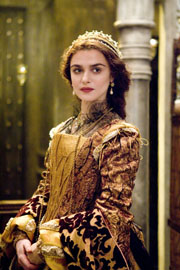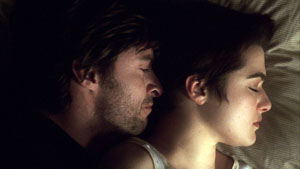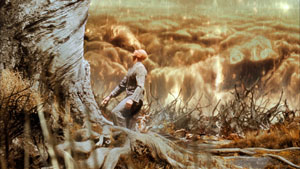
Throughout its history, film has been influenced by, and borrowed from, the literary world. Apart from acting as a source for some of the most the world’s enduring movie classics (film was once described as storytelling for the illiterate), plays and novels are definitely the origin of film’s three-act structure. And let’s not forget the recent fascination with trilogies, (even five-part ones à la Douglas Adams). While many filmmakers are under the illusion (or delusion) that they are making works of art that can only be displayed within the refined and hallowed halls of the arthouse cinema and/or international film festivals, with his latest film, Darren Aranofsky seems truly to have taken the artistic convention of the triptych and created a highly original, if sometimes unfathomable, opus.
Spanning two millennia, the film tells the tale of three incarnations of a man (Hugh Jackman in excellent form) obsessed with immortality and the woman (a perfectly cast Rachel Weisz) he loves. In 16th century Spain, he is conquistador Tomas who receives a map from a Franciscan monk showing him the location of the mythical Fountain of Youth among the Mayan ruins of Mexico. (This part of the film makes a nice segue from Mel Gibson’s latest directorial effort, APOCALYPTO.) In this section his love is Isabel, the Spanish Queen. Not only does Tomas have to battle against the Spanish Inquisition (and, no, we weren’t expecting them), but also against the jungle natives who protect the old Mayan temples, in his search for the mythical tree of life, in order to fulfil his promise and win the Queen’s hand.
 In the present-day portion of the film Jackman is Tommy Creo, a scientist who is desperately trying to find a cure for the tumour that is killing his wife Izzi. Weisz really shines in this role. Although he makes breakthroughs in regeneration, his obsession with extending life is a marked contrast to his wife’s acceptance of death. This is the most accessible section of the movie as it is a fairly straightforward love story, in the vein of LOVE STORY, but one still full of mystery.
In the present-day portion of the film Jackman is Tommy Creo, a scientist who is desperately trying to find a cure for the tumour that is killing his wife Izzi. Weisz really shines in this role. Although he makes breakthroughs in regeneration, his obsession with extending life is a marked contrast to his wife’s acceptance of death. This is the most accessible section of the movie as it is a fairly straightforward love story, in the vein of LOVE STORY, but one still full of mystery.
The futuristic section is set in the 26th Century as Jackman floats around space in a giant bubble. It’s not really clear if he is a cosmonaut or cosmic man, as he alternates between tranquil lotus-pose meditator and agitated tree hugger. This act is the hardest to fathom as it is metaphysical and mystical rather than just plain mysterious.
 What I found interesting, in connection with the previously mentioned idea of the film as a triptych, is that film calls to mind Bosch’s The Garden of Earthly Delights. When the panels of that artwork are closed they show a world enclosed in an orb. Whether this was planned by Aranofsky or simply a coincidence I don’t know. Triptychs are also used as altarpieces, and the director has definitely created a symbolic and allegorical tale of man’s quest for eternal life, one that serves as a warning to those who seek eternal life in the corporeal rather than the spiritual.
What I found interesting, in connection with the previously mentioned idea of the film as a triptych, is that film calls to mind Bosch’s The Garden of Earthly Delights. When the panels of that artwork are closed they show a world enclosed in an orb. Whether this was planned by Aranofsky or simply a coincidence I don’t know. Triptychs are also used as altarpieces, and the director has definitely created a symbolic and allegorical tale of man’s quest for eternal life, one that serves as a warning to those who seek eternal life in the corporeal rather than the spiritual.
As it switches back and forth between the different time zones, the film can be hard to follow and its lofty concepts may alienate audiences as they struggle to get to grips with what is happening on screen. Aranofsky’s films are never easy viewing, from the scratchy monochrome and mathematics of PI to the frenetic, drug-fuelled imagery of REQUIEM FOR A DREAM, but they are always thought-provoking and controversial, and THE FOUNTAIN is no exception.
The obsession of the film’s protagonist(s) could be seen as a reflection of the director’s own obsession with getting the film made. It has been a long on-again-off-again production, as Aranofsky wanted total creative control over the film, something that, for commercial reasons, most studios are reluctant to give to any but the most bankable directors, and even then rarely. To his credit, Aranofsky stuck to his guns and has produced a visually stunning piece of filmmaking; unfortunately it is going to struggle to find an audience. It is definitely not one for the popcorn crowd, but it will undoubtedly become a cult classic alongside auteur works such as Kubrick’s 2001: A SPACE ODYSSEY and Ken Russell’s ALTERED STATES, which were both hits with the chemically-enhanced viewers of their time. While I would never suggest that the best way of seeing this film is in a state of altered consciousness, it’s certainly not going to make any less sense if you do. In any case, an open mind is definitely advisable.
If the film appeals to you on any level at all, (unlike most of the critics who saw it at the Venice Film Festival last year), it is worth a second viewing. Alternatively, get hold of the graphic novel, to familiarise yourself with the concept. Aranofsky describes the graphic novel as his “director’s cut”, as it is based on the story as it was before it was rewritten in order to make it practical to produce as an affordable movie. Like the final film, the graphic novel is not a standard comic book adaptation thanks to Kent Williams stunning artwork. A review of the book can be found here. A cheaper paperback version is now available from Amazon.
Although the film may struggle to find an audience amongst the general cinema-going public, it will appeal to the discerning SCI-FI-LONDON audience who like evocative films that make them ponder life’s bigger questions.
THE FOUNTAIN is on release from January 26 through Twentieth Century Fox.
Watch the trailer and exclusive clips from the film here. They are in Windows Media (WMV) format. Mac users should download the free Flip4Mac plug-in to watch them.
